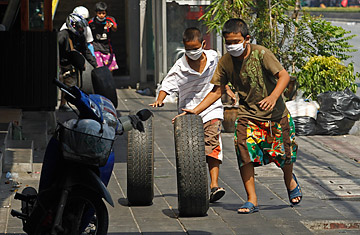
Young anti-government protesters collect tires for a demonstartion in central Bangkok, Thailand, May 15, 2010.
Updated, Monday May 17, 4.30 am ET
One of the most troubling aspects of the escalating political confrontation in Thailand is the children it places in harm's way. Leaders of the anti-government protest movement on Sunday spurned calls to remove children and the elderly from their sit-in in central Bangkok, even as soldiers surrounded their protest site and exchanges of gunfire left two dozen people dead on the capital's streets.
"Yes, I know it is dangerous, and I know there are children here," said Nattawut Saikua, one of the leaders of the United Front for Democracy Against Dictatorship, the anti-government group more commonly known as the Red Shirts. "We have privately asked their parents to take them and leave, but they insist they want to stay," he told TIME.
Thousands of Red Shirts from Bangkok and the provinces have occupied and shut down the Rajaprasong commercial district since April 3, demanding the resignation of Prime Minister Abhisit Vejjajiva and the holding of new elections. Many are supporters of former Prime Minister Thaksin Shinawatra, who was ousted in a coup in 2006, and claim that Abhisit rose to power through backroom deals with the military. Thaksin flew his three children out the country as the protest began. When negotiations between the government and protesters broke down on Wednesday, the Thai Army encircled the protest area, which covers approximately one square mile, preventing reinforcements, food and other supplies from entering the protest camp, while urging demonstrators to go home.
Meanwhile, Red Shirts and slum dwellers outside the protest area have attempted to attack the soldiers from behind using guns, grenades, rocks and homemade weapons. Clashes between the two sides over the weekend had left 37 dead and 266 injured by Monday. The most high-profile death is that of Major General Khattiya Sawasdiphol, better known as Seh Daeng, whose death from gunshot wounds was confirmed Monday, five days after being shot in the head by a sniper in downtown Bangkok while talking to journalists inside the perimeter of the protest site.
About 6,000 demonstrators remain within the Rajaprasong protest site. They include many elderly people, women and young children brought by their parents who came to rally in Bangkok from the provinces. Reporters have seen at least two dozen young children inside the protest zone, and there are possibly many more.
"I took my daughter with me because there was no one to take care of her back home when I came here," said Kaneung Pana, a day laborer from the northeastern province of Mukdahan. His eight-year-old daughter, Hongfah, wears a red dress and cuddles by his side. "I understand it is not safe, but we have to do something to pressure the government to resign." None of the Red Shirt leaders had asked him to take his daughter and go because of the danger, he said, but he would not leave even if they did.
Kampit Jooncha, a farmer from the same province, agreed that she would not take her ten-year-old son Chalor and abandon the protest no matter who asked. "We want democracy," she said. "If I have to die for it, I want my children to die with me."
Hongfah and Chalor both said they were not afraid, although Hongfah said she wished she were back in Mukdahan. Asked if they understood that something bad could happen at the protest, they both said no, they did not understand.
The presence of children and the elderly is one of the reasons the government and the military have been reluctant to use force to disperse the Red Shirts from a protest that has paralyzed the capital's commercial center for weeks. That, and the fact that Red Shirts, despite proclaiming themselves peaceful protesters, have a corps of guards dressed in black, some of whom are armed. On Saturday, children's rights activist and peace activists called on the Red Shirt leaders to evacuate children and the elderly. "In cases like this of high political tension, it is not in the best interest of the child to have them at a protest such as this," said Tomoo Hozumi, the UNICEF representative to Thailand. Wallop Tangkhananurak, head of the Children Creation Foundation, offered to take in any protesters' children at his foundation. None have accepted the offer.
Nattawut, speaking to TIME, strongly denied accusations that Red Shirt leaders wanted women and children present to deter soldiers from using force against their protest. "I guarantee you we will never use children or women as human shields," Nattawut insisted. Asked why Red Shirt leaders had not made an announcement from their rally stage telling parents with children to leave because of the danger, he said that was the job of the government.
On Sunday, the government asked its Ministry of Social Welfare and Human Development, the Thai Red Cross and other nongovernmental organizations to enter the protest site and try to convince parents with children and the elderly to return home. Nattawut finally responded by asking families and the elderly to move within the protest site to an area in front of a Buddhist temple where they could seek shelter inside if violence erupted.
Not many, however, made the move to the temple. Her arm around her son, farmer Kampit said she was staying where she was. "If we die together for democracy, it will be worth it," she said.
